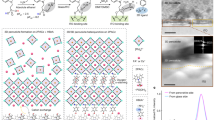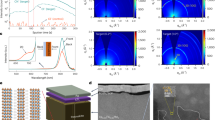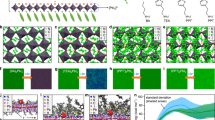Abstract
The energy landscape of reduced-dimensional perovskites (RDPs) can be tailored by adjusting their layer width (n). Recently, two/three-dimensional (2D/3D) heterostructures containing n = 1 and 2 RDPs have produced perovskite solar cells (PSCs) with >25% power conversion efficiency (PCE). Unfortunately, this method does not translate to inverted PSCs due to electron blocking at the 2D/3D interface. Here we report a method to increase the layer width of RDPs in 2D/3D heterostructures to address this problem. We discover that bulkier organics form 2D heterostructures more slowly, resulting in wider RDPs; and that small modifications to ligand design induce preferential growth of n ≥ 3 RDPs. Leveraging these insights, we developed efficient inverted PSCs (with a certified quasi-steady-state PCE of 23.91%). Unencapsulated devices operate at room temperature and around 50% relative humidity for over 1,000 h without loss of PCE; and, when subjected to ISOS-L3 accelerated ageing, encapsulated devices retain 92% of initial PCE after 500 h.
This is a preview of subscription content, access via your institution
Access options
Access Nature and 54 other Nature Portfolio journals
Get Nature+, our best-value online-access subscription
$29.99 / 30 days
cancel any time
Subscribe to this journal
Receive 12 print issues and online access
$209.00 per year
only $17.42 per issue
Buy this article
- Purchase on Springer Link
- Instant access to full article PDF
Prices may be subject to local taxes which are calculated during checkout





Similar content being viewed by others
Data availability
Source data are provided with this paper. All the data supporting the findings of this study are available within this article and its Supplementary Information. Any additional information can be obtained from corresponding authors upon request.
References
Yuan, M. et al. Perovskite energy funnels for efficient light-emitting diodes. Nat. Nanotechnol. 11, 872–877 (2016).
Wei, M. et al. Ultrafast narrowband exciton routing within layered perovskite nanoplatelets enables low-loss luminescent solar concentrators. Nat. Energy 4, 197–205 (2019).
Proppe, A. H. et al. Synthetic control over quantum well width distribution and carrier migration in low-dimensional perovskite photovoltaics. J. Am. Chem. Soc. 140, 2890–2896 (2018).
Quan, L. N. et al. Ligand-stabilized reduced-dimensionality perovskites. J. Am. Chem. Soc. 138, 2649–2655 (2016).
Jung, E. H. et al. Efficient, stable and scalable perovskite solar cells using poly(3-hexylthiophene). Nature 567, 511–515 (2019).
Min, H. et al. Efficient, stable solar cells by using inherent bandgap of α-phase formamidinium lead iodide. Science 366, 749–753 (2019).
Jeong, M. et al. Stable perovskite solar cells with efficiency exceeding 24.8% and 0.3-V voltage loss. Science 369, 1615–1620 (2020).
Jiang, Q. et al. Surface passivation of perovskite film for efficient solar cells. Nat. Photonics 13, 460–466 (2019).
Zhu, H. et al. Tailored amphiphilic molecular mitigators for stable perovskite solar cells with 23.5% efficiency. Adv. Mater. 32, 1907757 (2020).
Liu, Y. et al. Ultrahydrophobic 3D/2D fluoroarene bilayer-based water-resistant perovskite solar cells with efficiencies exceeding 22%. Sci. Adv. 5, eaaw2543 (2019).
Kim, G. et al. Impact of strain relaxation on performance of α-formamidinium lead iodide perovskite solar cells. Science 370, 108–112 (2020).
Jeong, J. et al. Pseudo-halide anion engineering for α-FAPbI3 perovskite solar cells. Nature 592, 381–385 (2021).
Teale, S. et al. Dimensional mixing increases the efficiency of 2D/3D perovskite solar cells. J. Phys. Chem. Lett. 11, 5115–5119 (2020).
Yoo, J. J. et al. An interface stabilized perovskite solar cell with high stabilized efficiency and low voltage loss. Energy Environ. Sci. 12, 2192–2199 (2019).
Hu, Y. et al. Hybrid perovskite/perovskite heterojunction solar cells. ACS Nano 10, 5999–6007 (2016).
Proppe, A. H. et al. Multication perovskite 2D/3D interfaces form via progressive dimensional reduction. Nat. Commun. 12, 3472 (2021).
Jang, Y. W. et al. Intact 2D/3D halide junction perovskite solar cells via solid-phase in-plane growth. Nat. Energy 6, 63–71 (2021).
Zhang, T. et al. Stable and efficient 3D-2D perovskite-perovskite planar heterojunction solar cell without organic hole transport layer. Joule 2, 2706–2721 (2018).
Bai, S. et al. Planar perovskite solar cells with long-term stability using ionic liquid additives. Nature 571, 245–250 (2019).
Lin, Y. H. et al. A piperidinium salt stabilizes efficient metal-halide perovskite solar cells. Science 369, 96–102 (2020).
Zheng, X. et al. Managing grains and interfaces via ligand anchoring enables 22.3%-efficiency inverted perovskite solar cells. Nat. Energy 5, 131–140 (2020).
Chen, S., Xiao, X., Gu, H. & Huang, J. Iodine reduction for reproducible and high-performance perovskite solar cells and modules. Sci. Adv. 7, eabe8130 (2021).
Chen, C. et al. Arylammonium-assisted reduction of the open-circuit voltage deficit in wide-bandgap perovskite solar cells: the role of suppressed ion migration. ACS Energy Lett. 5, 2560–2568 (2020).
Bai, Y. et al. Dimensional engineering of a graded 3D–2D halide perovskite interface enables ultrahigh Voc enhanced stability in the p-i-n photovoltaics. Adv. Energy Mater. 7, 1701038 (2017).
Park, S. M., Abtahi, A., Boehm, A. M. & Graham, K. R. Surface ligands for methylammonium lead iodide films: surface coverage, energetics, and photovoltaic performance. ACS Energy Lett. 5, 799–806 (2020).
La-Placa, M. G. et al. Vacuum-deposited 2D/3D perovskite heterojunctions. ACS Energy Lett. 4, 2893–2901 (2019).
Zhao, T., Chueh, C.-C., Chen, Q., Rajagopal, A. & Jen, A. K.-Y. Defect passivation of organic–inorganic hybrid perovskites by diammonium iodide toward high-performance photovoltaic devices. ACS Energy Lett. 1, 757–763 (2016).
Proppe, A. H. et al. Photochemically cross-linked quantum well ligands for 2D/3D perovskite photovoltaics with improved photovoltage and stability. J. Am. Chem. Soc. 141, 14180–14189 (2019).
Mahmud, M. A. et al. Double‐sided surface passivation of 3D perovskite film for high‐efficiency mixed‐dimensional perovskite solar cells. Adv. Funct. Mater. 30, 1907962 (2020).
Burgelman, M., Nollet, P. & Degrave, S. Modelling polycrystalline semiconductor solar cells. Thin Solid Films 361–362, 527–532 (2000).
Zhou, L. et al. Highly efficient and stable planar perovskite solar cells with modulated diffusion passivation toward high power conversion efficiency and ultrahigh fill factor. Sol. RRL 3, 1900293 (2019).
Cao, D. H., Stoumpos, C. C., Farha, O. K., Hupp, J. T. & Kanatzidis, M. G. 2D homologous perovskites as light-absorbing materials for solar cell applications. J. Am. Chem. Soc. 137, 7843–7850 (2015).
Ma, J. & Wang, L. W. Nanoscale charge localization induced by random orientations of organic molecules in hybrid perovskite CH3NH3PbI3. Nano Lett. 15, 248–253 (2015).
Quintero-Bermudez, R. et al. Compositional and orientational control in metal halide perovskites of reduced dimensionality. Nat. Mater. 17, 900–907 (2018).
Hu, J. et al. Synthetic control over orientational degeneracy of spacer cations enhances solar cell efficiency in two-dimensional perovskites. Nat. Commun. 10, 1276 (2019).
Niu, T. et al. Interfacial engineering at the 2D/3D heterojunction for high-performance perovskite solar cells. Nano Lett. 19, 7181–7190 (2019).
Gharibzadeh, S. et al. Record open‐circuit voltage wide‐bandgap perovskite solar cells utilizing 2D/3D perovskite heterostructure. Adv. Energy Mater. 9, 1803699 (2019).
Briggs, D. & Seah, M. P. (eds) Practical Surface Analysis. Auger and X-ray Photoelectron Spectroscopy 2nd edn, Vol. 1 (Wiley, 1990).
Boehm, A. M., Liu, T., Park, S. M., Abtahi, A. & Graham, K. R. Influence of surface ligands on energetics at FASnI3/C60 interfaces and their impact on photovoltaic performance. ACS Appl. Mater. Interfaces 12, 5209–5218 (2020).
Yoshida, H. Near-ultraviolet inverse photoemission spectroscopy using ultra-low energy electrons. Chem. Phys. Lett. 539–540, 180–185 (2012).
Boehm, A. M., Wieser, J., Butrouna, K. & Graham, K. R. A new photon source for ultraviolet photoelectron spectroscopy of organic and other damage-prone materials. Org. Electron. 41, 9–16 (2017).
Endres, J. et al. Valence and conduction band densities of states of metal halide perovskites: a combined experimental–theoretical study. J. Phys. Chem. Lett. 7, 2722–2729 (2016).
She, X. J. et al. A solvent-based surface cleaning and passivation technique for suppressing ionic defects in high-mobility perovskite field-effect transistors. Nat. Electron. 3, 694–703 (2020).
Kirchartz, T., Márquez, J. A., Stolterfoht, M. & Unold, T. Photoluminescence‐based characterization of halide perovskites for photovoltaics. Adv. Energy Mater. 10, 1904134 (2020).
Zhou, M., Sarmiento, J. S., Fei, C. & Wang, H. Charge transfer and diffusion at the perovskite/PCBM interface probed by transient absorption and reflection. J. Phys. Chem. C 123, 22095–22103 (2019).
Proppe, A. H. et al. Spectrally resolved ultrafast exciton transfer in mixed perovskite quantum wells. J. Phys. Chem. Lett. 10, 419–426 (2019).
Shao, Y., Yuan, Y. & Huang, J. Correlation of energy disorder and open-circuit voltage in hybrid perovskite solar cells. Nat. Energy 1, 15001 (2016).
Chen, W. et al. Efficient and stable large-area perovskite solar cells with inorganic charge extraction layers. Science 350, 944–948 (2015).
Ma, F. et al. Nickel oxide for inverted structure perovskite solar cells. J. Energy Chem. 52, 393–411 (2020).
Boyd, C. C. et al. Overcoming redox reactions at perovskite–nickel oxide interfaces to boost voltages in perovskite solar cells. Joule 4, 1759–1775 (2020).
Sutanto, A. A. et al. Dynamical evolution of the 2D/3D interface: a hidden driver behind perovskite solar cell instability. J. Mater. Chem. A 8, 2343–2348 (2020).
Khenkin, M. V. et al. Consensus statement for stability assessment and reporting for perovskite photovoltaics based on ISOS procedures. Nat. Energy 5, 35–49 (2020).
Lu, H. et al. Vapor-assisted deposition of highly efficient, stable black-phase FAPbI3 perovskite solar cells. Science 370, eabb8985 (2020).
Chen, H. et al. Efficient and stable inverted perovskite solar cells incorporating secondary amines. Adv. Mater. 31, 1903559 (2019).
Chen, H. et al. Band alignment towards high-efficiency NiOx-based Sn-Pb mixed perovskite solar cells. Sci. China Mater. 64, 537–546 (2021).
Ilavsky, J. Nika: software for two-dimensional data reduction. J. Appl. Crystallogr. 45, 324–328 (2012).
Jiang, Z. GIXSGUI: a MATLAB toolbox for grazing-incidence X-ray scattering data visualization and reduction, and indexing of buried three-dimensional periodic nanostructured films. J. Appl. Crystallogr. 48, 917–926 (2015).
Sader, J. E. et al. Spring constant calibration of atomic force microscope cantilevers of arbitrary shape. Rev. Sci. Instrum. 83, 103705 (2012).
Sader, J. E., Lu, J. & Mulvaney, P. Effect of cantilever geometry on the optical lever sensitivities and thermal noise method of the atomic force microscope. Rev. Sci. Instrum. 85, 113702 (2014).
Acknowledgements
This research was made possible by the US Department of the Navy, Office of Naval Research Grant (N00014-20-1-2572). This work was supported in part by the Ontario Research Fund-Research Excellence program (ORF7-Ministry of Research and Innovation, Ontario Research Fund-Research Excellence Round 7). We appreciate the Shanghai Synchrotron Radiation Facility (beamline 14B and 16B) and X. Gao and Z. Su for their help with GIWAXS characterization. Z.N. is grateful for support by the National Key Research Program (2021YFA0715502, 2016YFA0204000) and the National Science Fund of China (61935016). S.M.P., H.R.A. and K.R.G. acknowledge the US Department of Energy under Grant DE-SC0018208 for supporting the UPS and IPES measurements. T.F. and T.C. acknowledge the Canadian Foundation for Innovation and the Natural Science and Engineering Council of Canada (NSERC) for KPFM measurements. F.L and Y.G. were funded by the King Abdullah University of Science and Technology (KAUST) Office of Sponsored Research (OSR) under Award No: OSR-CARF/CCF-3079 and OSR-2018-CRG7-3737.
Author information
Authors and Affiliations
Contributions
H.C., S.T., B.C. and Y.H. conceived the idea. H.C., K.B., L.G. and S.T. prepared samples for characterization. S.M.P. and H.R.A. performed UPS and IPES measurements, and S.M.P., H.R.A., S.T. and K.R.G. analysed the data. S.T. performed the TA experiments and analysed the data with Y.G. and F.L. The in situ TA system for use in this paper was developed by S.T., A.K.J. and A.H.P. The in situ measurements were performed by S.T. who also analysed the data. T.Z. performed the DFT calculations and analysed the data. B.C. performed PLQY measurements and H.C. measured the PL lifetimes. M.W. carried out the transient photocurrent and photovoltage measurements and S.T. analysed the data. S.T. performed SCAPS simulations. S.T. collected the thin-film X-ray diffraction patterns. C.H. and D.Y. performed the GIWAXS experiments and obtained the SEM images. S.T. and B.C. analysed the data. The KPFM measurements were performed by T.C., and T.F. analysed the data. H.C. and W.Z. carried out the SCLC measurements and S.T. analysed the data. S.T. conducted the c-AFM measurements. H.C. fabricated all the devices for performance and certification, B.C. and S.H. helped with device certification. B.C. built the heated MPP-tracking station. Q.Z., K.X. and C.Z. carried out the UPS on bulk 2D films. Z.N. and E.H.S. supervised and funded the work. S.T. wrote the draft manuscript with input from B.C. and E.H.S. All authors contributed to the revision of the final paper.
Corresponding authors
Ethics declarations
Competing interests
The authors declare no competing interests.
Peer review
Peer review information
Nature Photonics thanks Mohammad Khaja Nazeeruddin, Ling Xu the other, anonymous, reviewer(s) for their contribution to the peer review of this work.
Additional information
Publisher’s note Springer Nature remains neutral with regard to jurisdictional claims in published maps and institutional affiliations.
Supplementary information
Supplementary Information
Supplementary Text 1–6 and Figs. 1–46.
Source data
Source Data Fig. 1
Unprocessed UPS data for bulk 2D perovskite films.
Source Data Fig. 2
Unprocessed TA and in situ TA data.
Source Data Fig. 3
Coordinates from DFT calculations.
Source Data Fig. 4
Unprocessed IPES data from 2D/3D heterostructures.
Source Data Fig. 5
Normalized PL lifetimes and transient photocurrent data. Device J–V and stability data.
Rights and permissions
About this article
Cite this article
Chen, H., Teale, S., Chen, B. et al. Quantum-size-tuned heterostructures enable efficient and stable inverted perovskite solar cells. Nat. Photon. 16, 352–358 (2022). https://doi.org/10.1038/s41566-022-00985-1
Received:
Accepted:
Published:
Issue Date:
DOI: https://doi.org/10.1038/s41566-022-00985-1
This article is cited by
-
Harnessing strong aromatic conjugation in low-dimensional perovskite heterojunctions for high-performance photovoltaic devices
Nature Communications (2024)
-
Frequency-selective perovskite photodetector for anti-interference optical communications
Nature Communications (2024)
-
Enhancing the efficiency and longevity of inverted perovskite solar cells with antimony-doped tin oxides
Nature Energy (2024)
-
Spin coating epitaxial heterodimensional tin perovskites for light-emitting diodes
Nature Nanotechnology (2024)
-
Double-side 2D/3D heterojunctions for inverted perovskite solar cells
Nature (2024)



